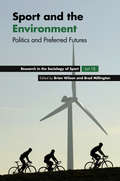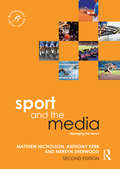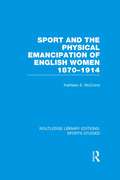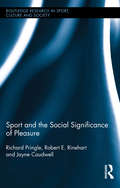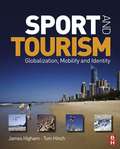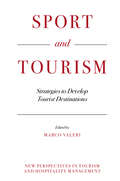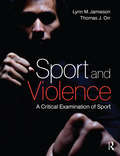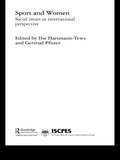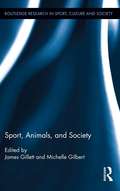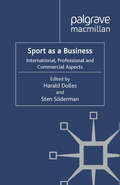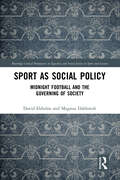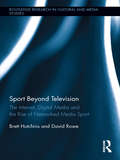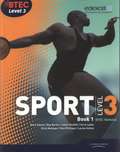- Table View
- List View
Sport and the Environment: Politics and Preferred Futures (Research in the Sociology of Sport #13)
by Brian Wilson Brad MillingtonSport and the environment are inextricably linked. Sport is dependent on its environmental contexts and is potentially environmentally impactful in its own right. Sport facilities – like ski hills, golf courses, and stadiums – can upset ecosystems and displace local residents. Teams and fans commonly travel in cars and planes that emit CO2. Rising temperatures might make participation in some sports impossible. Other examples abound. Yet while sport can be environmentally damaging, there is also hope that it can be a force for positive environmental change – for example, in modelling pro-environment forms of sport, and in decision-making by sport’s many stakeholders. In a context where pressing concerns about the climate crisis have inspired calls for changes in how people relate to the environment, questions remain about the environmental sustainability of sport. Such questions are at the core of Sport and the Environment: Politics and Preferred Futures, which brings together a diverse collection of contributors to explore a range of topics, such as how sport is implicated in environmentally damaging activities, how decisions about responding to environmental issues are made, who benefits most and least from these decisions, and, ultimately, what a truly environmentally-friendly sport could look like.
Sport and the Environment: Politics and Preferred Futures (Research in the Sociology of Sport #13)
by Brian Wilson Brad MillingtonSport and the environment are inextricably linked. Sport is dependent on its environmental contexts and is potentially environmentally impactful in its own right. Sport facilities – like ski hills, golf courses, and stadiums – can upset ecosystems and displace local residents. Teams and fans commonly travel in cars and planes that emit CO2. Rising temperatures might make participation in some sports impossible. Other examples abound. Yet while sport can be environmentally damaging, there is also hope that it can be a force for positive environmental change – for example, in modelling pro-environment forms of sport, and in decision-making by sport’s many stakeholders. In a context where pressing concerns about the climate crisis have inspired calls for changes in how people relate to the environment, questions remain about the environmental sustainability of sport. Such questions are at the core of Sport and the Environment: Politics and Preferred Futures, which brings together a diverse collection of contributors to explore a range of topics, such as how sport is implicated in environmentally damaging activities, how decisions about responding to environmental issues are made, who benefits most and least from these decisions, and, ultimately, what a truly environmentally-friendly sport could look like.
Sport and the Media: Managing the Nexus (Sport Management Series)
by Matthew Nicholson Anthony Kerr Merryn SherwoodSuccessful media relations and a sound communication strategy are essential for all sport organizations. Any successful manager working in sport must have a clear understanding of how the media works, as well as the practical skills to manage the communication process. Now in a fully revised and updated second edition, Sport and the Media: Managing the Nexus is still the only textbook to combine in-depth analysis of the rapidly developing sport media industry with a clear and straightforward guide to practical sport media management skills. The book explains the commercial relationships that exist between key media and sport organisations and how to apply a range of tools and strategies to promote the achievements of sport organisations. This updated edition includes a wider range of international examples and cases, as well as four completely new chapters covering new and social media, managing the media at major sports events, the work of the sports journalist, and the role of the sport media manager. The book's online resources have also been updated, with new lecture slides and teaching notes providing a complete package for instructors. Sport and the Media is an essential textbook for any degree level course on sport and the media, sport media management or sport communication, and invaluable reading for any sport media or sport management practitioner looking to improve their professional skills.
Sport and the Media: Managing the Nexus (Sport Management Series)
by Matthew Nicholson Anthony Kerr Merryn SherwoodSuccessful media relations and a sound communication strategy are essential for all sport organizations. Any successful manager working in sport must have a clear understanding of how the media works, as well as the practical skills to manage the communication process. Now in a fully revised and updated second edition, Sport and the Media: Managing the Nexus is still the only textbook to combine in-depth analysis of the rapidly developing sport media industry with a clear and straightforward guide to practical sport media management skills. The book explains the commercial relationships that exist between key media and sport organisations and how to apply a range of tools and strategies to promote the achievements of sport organisations. This updated edition includes a wider range of international examples and cases, as well as four completely new chapters covering new and social media, managing the media at major sports events, the work of the sports journalist, and the role of the sport media manager. The book's online resources have also been updated, with new lecture slides and teaching notes providing a complete package for instructors. Sport and the Media is an essential textbook for any degree level course on sport and the media, sport media management or sport communication, and invaluable reading for any sport media or sport management practitioner looking to improve their professional skills.
Sport and the Physical Emancipation of English Women: 1870-1914 (Routledge Library Editions: Sports Studies)
by Kathleen McCroneThe nineteenth century was a golden age in British sports. Not only were sports immensely popular, but they began to assume the forms and qualities that still characterise them today. Moreover, the latter part of the century saw a significant participation in sports by women, and this book provides the first overall examination of this early development and the social changes that it helped to bring about. Since women’s entry into sports was chiefly a consequence of the campaign for better female education, the book begins with an account of sports at the Oxbridge women’s colleges, at the girls' public schools and at the new women’s physical training colleges. It then examines team sports such as hockey, lacrosse, and cricket and individual sports such as tennis, golf and cycling. Other chapters discuss the medical attitudes and prejudices toward women’s participation in sports and the role of sports in changing female dress.
Sport and the Physical Emancipation of English Women: 1870-1914 (Routledge Library Editions: Sports Studies)
by Kathleen McCroneThe nineteenth century was a golden age in British sports. Not only were sports immensely popular, but they began to assume the forms and qualities that still characterise them today. Moreover, the latter part of the century saw a significant participation in sports by women, and this book provides the first overall examination of this early development and the social changes that it helped to bring about. Since women’s entry into sports was chiefly a consequence of the campaign for better female education, the book begins with an account of sports at the Oxbridge women’s colleges, at the girls' public schools and at the new women’s physical training colleges. It then examines team sports such as hockey, lacrosse, and cricket and individual sports such as tennis, golf and cycling. Other chapters discuss the medical attitudes and prejudices toward women’s participation in sports and the role of sports in changing female dress.
Sport and the Social Significance of Pleasure (Routledge Research in Sport, Culture and Society)
by Jayne Caudwell Robert E. Rinehart Richard PringleThis innovative text's critical examination foregrounds the prime reason why so many people participate in or watch sport – pleasure. Although there has been a "turn" to emotions and affect within academia over the last two decades, it has been somewhat remiss that pleasure, as an integral aspect of human life, has not received greater attention from sociologists of sport, exercise and physical education. This book addresses this issue via an unabashed examination of sport and the moving body via a "pleasure lens." It provides new insights about the production of various identities, power relations and social issues, and the dialectical links between the socio-cultural and the body. Taking a wide-sweeping view of pleasure - dignified and debauched, distinguished and mundane – it examines topics as diverse as aging, health, fandom, running, extreme sports, biopolitics, consumerism, feminism, sex and sexuality. In drawing from diverse theoretical approaches and original empirical research, the text reveals the social and political significance of pleasure and provides a more rounded, dynamic and sensual account of sport.
Sport and the Social Significance of Pleasure (Routledge Research in Sport, Culture and Society #42)
by Jayne Caudwell Robert E. Rinehart Richard PringleThis innovative text's critical examination foregrounds the prime reason why so many people participate in or watch sport – pleasure. Although there has been a "turn" to emotions and affect within academia over the last two decades, it has been somewhat remiss that pleasure, as an integral aspect of human life, has not received greater attention from sociologists of sport, exercise and physical education. This book addresses this issue via an unabashed examination of sport and the moving body via a "pleasure lens." It provides new insights about the production of various identities, power relations and social issues, and the dialectical links between the socio-cultural and the body. Taking a wide-sweeping view of pleasure - dignified and debauched, distinguished and mundane – it examines topics as diverse as aging, health, fandom, running, extreme sports, biopolitics, consumerism, feminism, sex and sexuality. In drawing from diverse theoretical approaches and original empirical research, the text reveals the social and political significance of pleasure and provides a more rounded, dynamic and sensual account of sport.
Sport and Tourism
by James Higham Tom HinchSport and Tourism: Globalization, Mobility and Identity marks a new era in sport tourism texts. Written by global experts whose previous collaborations have been integral to the development of the field, the book applies key social science concepts and issues relevant to the academic study of sport and tourism. This is a ground-breaking text, which: Critically explores the wider manifestations of sport-related tourism and mobilityAddresses key themes such as globalization, mobility and identity Explores the unique interrelationship that exists in a sport tourism context between activity, people and place Includes case studies written by a range of leading scholars from around the world Set to be the an essential text for any student or academic in the field, this book cements and advances previous studies by building upon existing literature, while extending the field by exploring avenues of study that are yet to be comprehensively addressed. The latest collaboration by internationally renowned authors applies new theoretical perspectives for the advancement of sport tourism.
Sport and Tourism
by James Higham Tom HinchSport and Tourism: Globalization, Mobility and Identity marks a new era in sport tourism texts. Written by global experts whose previous collaborations have been integral to the development of the field, the book applies key social science concepts and issues relevant to the academic study of sport and tourism. This is a ground-breaking text, which: Critically explores the wider manifestations of sport-related tourism and mobilityAddresses key themes such as globalization, mobility and identity Explores the unique interrelationship that exists in a sport tourism context between activity, people and place Includes case studies written by a range of leading scholars from around the world Set to be the an essential text for any student or academic in the field, this book cements and advances previous studies by building upon existing literature, while extending the field by exploring avenues of study that are yet to be comprehensively addressed. The latest collaboration by internationally renowned authors applies new theoretical perspectives for the advancement of sport tourism.
Sport and Tourism: Strategies to Develop Tourist Destinations (New Perspectives in Tourism and Hospitality Management)
by Marco ValeriThe links between high profile sports events and tourism are increasingly apparent, yet comparatively little attention has been paid to lower profile sports-related travel. Developing this type of travel provides clear economic and social impacts - employment opportunities, investment, development, the foundation of new infrastructure and the improvement and reinforcement of local communities. Sport and Tourism offers a comprehensive analysis of how and why interorganizational cooperation between sports and tourism occurs to develop tourist destinations. Considering new strategies and crisis management programs, the chapter authors cover a range of sports from football and cycling to winter sports and hiking in countries around the world, such as China, Croatia, Greece, India, Italy, Malaysia, Portugal, UK and Slovakia. In confronting growing concerns around environmental, social and economic issues facing sports and tourism, this collection presents different perspectives to develop new plans for future needs and problems. Sport and Tourism provides an opportunity to stimulate academic research on the relationship between sport and tourism with multidisciplinary approaches. Furthermore, this work encourages discussion among international scholars on how to stimulate cooperation strategies on sport and tourism to develop tourist destinations.
Sport and Tourism: Strategies to Develop Tourist Destinations (New Perspectives in Tourism and Hospitality Management)
by Marco ValeriThe links between high profile sports events and tourism are increasingly apparent, yet comparatively little attention has been paid to lower profile sports-related travel. Developing this type of travel provides clear economic and social impacts - employment opportunities, investment, development, the foundation of new infrastructure and the improvement and reinforcement of local communities. Sport and Tourism offers a comprehensive analysis of how and why interorganizational cooperation between sports and tourism occurs to develop tourist destinations. Considering new strategies and crisis management programs, the chapter authors cover a range of sports from football and cycling to winter sports and hiking in countries around the world, such as China, Croatia, Greece, India, Italy, Malaysia, Portugal, UK and Slovakia. In confronting growing concerns around environmental, social and economic issues facing sports and tourism, this collection presents different perspectives to develop new plans for future needs and problems. Sport and Tourism provides an opportunity to stimulate academic research on the relationship between sport and tourism with multidisciplinary approaches. Furthermore, this work encourages discussion among international scholars on how to stimulate cooperation strategies on sport and tourism to develop tourist destinations.
Sport and Violence
by Lynn M Jamieson Thomas OrrSport and Violence takes a critical look at the culture of ‘sports rage’ and aggression in the sporting industry, covering ethical, historical and sociological causes and impacts. It examines international examples of sport violence, including: the father of a tennis competitor placing a drug in the drinks of her competitors; a player’s neck broken after being attacked from behind by an opponent in an NHL game; hooliganism in international soccer and more. The book not only attempts to explain how and why such violence originates, it examines its impact on society outside sport and suggests potential remedies for the problem. This book: Examines the culture of violence that permeates and surrounds sport, including the sociological causes of that violence, and what can be done to mitigate them Features an international perspective with examples of sport violence from throughout the world Offers a historical view on the evolution of violence in sport Its up-to-date and in-depth coverage of a controversial issue makes this book a valuable asset to both sports students and professionals working in sports management.
Sport and Violence
by Lynn M Jamieson Thomas OrrSport and Violence takes a critical look at the culture of ‘sports rage’ and aggression in the sporting industry, covering ethical, historical and sociological causes and impacts. It examines international examples of sport violence, including: the father of a tennis competitor placing a drug in the drinks of her competitors; a player’s neck broken after being attacked from behind by an opponent in an NHL game; hooliganism in international soccer and more. The book not only attempts to explain how and why such violence originates, it examines its impact on society outside sport and suggests potential remedies for the problem. This book: Examines the culture of violence that permeates and surrounds sport, including the sociological causes of that violence, and what can be done to mitigate them Features an international perspective with examples of sport violence from throughout the world Offers a historical view on the evolution of violence in sport Its up-to-date and in-depth coverage of a controversial issue makes this book a valuable asset to both sports students and professionals working in sports management.
Sport and Women: Social Issues in International Perspective (International Society For Comparative Physical Education And Sport Ser.)
by Ilse Hartmann-Tews Gertrud PfisterAlthough female athletes are successful in all types of sport, in many countries sport is still a male domain. This book examines and compares the sporting experiences of women from different countries around the world and offers the first systematic and cross-cultural analysis of the topic of women in sport.Sport and Women presents a wealth of new research data, including in-depth case-studies of 16 countries in North and South America, Asia, Eastern and Western Europe and Africa. In addition, the book offers comparative assessments of the extent to which women are represented in global sport and the opportunities that women have to participate in decision-making processes in sport.The book illuminates a wide range of key international issues in women's sport, such as cultural barriers to participation and the efficacy of political action. It is therefore essential reading for anybody with an interest in the sociology, culture and politics of sport.
Sport and Women: Social Issues in International Perspective
by Gertrud Pfister Ilse Hartmann-TewsAlthough female athletes are successful in all types of sport, in many countries sport is still a male domain. This book examines and compares the sporting experiences of women from different countries around the world and offers the first systematic and cross-cultural analysis of the topic of women in sport.Sport and Women presents a wealth of new research data, including in-depth case-studies of 16 countries in North and South America, Asia, Eastern and Western Europe and Africa. In addition, the book offers comparative assessments of the extent to which women are represented in global sport and the opportunities that women have to participate in decision-making processes in sport.The book illuminates a wide range of key international issues in women's sport, such as cultural barriers to participation and the efficacy of political action. It is therefore essential reading for anybody with an interest in the sociology, culture and politics of sport.
Sport, Animals, and Society (Routledge Research in Sport, Culture and Society #31)
by James Gillett Michelle GilbertThis book advances current literature on the role and place of animals in sport and society. It explores different forms of sporting spaces, examines how figures of animals have been used to racialize the human athlete, and encourages the reader to think critically about animal ethics, animals in space, time and place, and the human-animal relationship. The chapters highlight persistent dichotomies in the use of and collaboration with animals for sport, and present strategies for moving forward in the study of interspecies relations.
Sport, Animals, and Society (Routledge Research in Sport, Culture and Society)
by James Gillett Michelle GilbertThis book advances current literature on the role and place of animals in sport and society. It explores different forms of sporting spaces, examines how figures of animals have been used to racialize the human athlete, and encourages the reader to think critically about animal ethics, animals in space, time and place, and the human-animal relationship. The chapters highlight persistent dichotomies in the use of and collaboration with animals for sport, and present strategies for moving forward in the study of interspecies relations.
Sport as a Business: International, Professional and Commercial Aspects
by Harald Dolles and Sten SodermanSport has a number of distinctive characteristics whichimpact onthe extent of its globalization. This book seeks to gain a deeper understanding of the unique development in sports, its governance, its logic of co-creation of value and the advancement of the industry towards internationalisation, professionalization and commercialization
Sport as Social Policy: Midnight Football and the Governing of Society (Routledge Critical Perspectives on Equality and Social Justice in Sport and Leisure)
by David Ekholm Magnus DahlstedtThis book analyses the increasing use of sport in European and Western welfare states as a tool of social policy and its promotion as a solution to social problems. Midnight Football is a sports-based intervention targeting social inclusion and crime prevention in young people aged 12–25 in Sweden. This book takes a close look at its organization, pedagogy and potential outcomes. Drawing on cutting-edge research into Midnight Football in Sweden, and exploring other community sport programmes including Midnight Basketball in the United States, this book shines new light on broader social transformations regarding urban segregation and social exclusion, social policy and the governing of welfare and social policy. This book also offers new perspectives on how sport and the lives of young people intersect with and shape broader shifts in welfare and social policy in Western states, shifts that are manifested in increased inequality, social polarization and profound changes in urban geographies. This is fascinating reading for anybody with an interest in the relationships between sport and wider society, or in sport development, sport policy, social policy, public policy or youth and social work.
Sport as Social Policy: Midnight Football and the Governing of Society (Routledge Critical Perspectives on Equality and Social Justice in Sport and Leisure)
by David Ekholm Magnus DahlstedtThis book analyses the increasing use of sport in European and Western welfare states as a tool of social policy and its promotion as a solution to social problems. Midnight Football is a sports-based intervention targeting social inclusion and crime prevention in young people aged 12–25 in Sweden. This book takes a close look at its organization, pedagogy and potential outcomes. Drawing on cutting-edge research into Midnight Football in Sweden, and exploring other community sport programmes including Midnight Basketball in the United States, this book shines new light on broader social transformations regarding urban segregation and social exclusion, social policy and the governing of welfare and social policy. This book also offers new perspectives on how sport and the lives of young people intersect with and shape broader shifts in welfare and social policy in Western states, shifts that are manifested in increased inequality, social polarization and profound changes in urban geographies. This is fascinating reading for anybody with an interest in the relationships between sport and wider society, or in sport development, sport policy, social policy, public policy or youth and social work.
Sport Beyond Television: The Internet, Digital Media and the Rise of Networked Media Sport (Routledge Research in Cultural and Media Studies)
by Brett Hutchins David RoweTelevision is no longer the only screen delivering footage and news to people about sport. Computers, the Internet, Web, mobile and other digital media are increasingly important technologies in the production and consumption of sports media. Sport Beyond Television analyzes the changes that have given rise to this situation, combining theoretical insights with original evidence collected through extensive research and interviews with people working in the media and sport industries. It locates sports media as a pivotal component in online content economies and cultures, and counteracts the scant scholarly attention to sports media when compared to music, film and publishing in convergent media cultures. An expanding array of popular sports media – industry, user, club, athlete and fan produced – is now available and accessible in networked digital communications environments. This change is confounding the thinking of major sports organizations that have lived off the generous revenue flowing from exclusive broadcast contracts with free-to-air and subscription television networks for the last five decades. These developments are creating commercial and policy confusion, particularly as sports audiences and the advertising market fragment in line with the proliferation of niche channels and sources of digital sports media. Chapters in this title examine the shift from broadcast to online sports media markets, the impact of social networking platforms like Twitter and Facebook, evolving user and fan practices, the changing character of sports journalism, and the rise of sports computer gaming. Each chapter traces the socio-cultural implications of trends and trajectories in media sport.
Sport Beyond Television: The Internet, Digital Media and the Rise of Networked Media Sport (Routledge Research in Cultural and Media Studies)
by Brett Hutchins David RoweTelevision is no longer the only screen delivering footage and news to people about sport. Computers, the Internet, Web, mobile and other digital media are increasingly important technologies in the production and consumption of sports media. Sport Beyond Television analyzes the changes that have given rise to this situation, combining theoretical insights with original evidence collected through extensive research and interviews with people working in the media and sport industries. It locates sports media as a pivotal component in online content economies and cultures, and counteracts the scant scholarly attention to sports media when compared to music, film and publishing in convergent media cultures. An expanding array of popular sports media – industry, user, club, athlete and fan produced – is now available and accessible in networked digital communications environments. This change is confounding the thinking of major sports organizations that have lived off the generous revenue flowing from exclusive broadcast contracts with free-to-air and subscription television networks for the last five decades. These developments are creating commercial and policy confusion, particularly as sports audiences and the advertising market fragment in line with the proliferation of niche channels and sources of digital sports media. Chapters in this title examine the shift from broadcast to online sports media markets, the impact of social networking platforms like Twitter and Facebook, evolving user and fan practices, the changing character of sports journalism, and the rise of sports computer gaming. Each chapter traces the socio-cultural implications of trends and trajectories in media sport.
Sport Book 1: BTEC Level 3 (PDF)
by Chris Mulligan Mark Adams Adam Gledhill Chris Lydon Pam Phillippo Ray Barker Louise SuttonResources designed to support learners of the 2010 BTEC Level 3 National in Sport specification. Assessment activities in each unit give students plenty of practice to deepen their knowledge and understanding, and grading tips for every activity help them to achieve their best possible grade. WorkSpace case studies take learners into the real world of work, showing them how they can apply their knowledge in a real-life context.
Sport Branding Insights (Sport Business Insights)
by Constantino Stavros Aaron C.T. SmithIn a sporting world dominated by media and money, an understanding of sport branding is an essential skill for any sport manager. Success means being able to ‘brand’ – and therefore differentiate – a sport club, player, code, or event in a highly competitive entertainment market. For anyone seeking to understand or manage sport, this book offers an immediate and salient insight into the complex and dynamic process of creating a powerful sport brand. The book explains how a sport brand goes beyond just an identifying badge, reinforced by a name or a logo that helps sport consumers recognise a product or an organisation. It reveals how a brand becomes linked with consumers’ opinions and perceptions of a sport product and the organisation that owns it. Readers will learn how to create a powerful brand that has both recognition in the market and strong associated imagery, by imbuing it with a spirit of the past through appeals to tradition, by endowing it with human qualities of emotionality, thought, and volition, and through the use of characters, colours, texts, and symbols. It also provides a brief guide to the new domains of digital sport branding and social media. Concise, informative, and entertaining, this is an essential resource for anyone exploring or practising the business of sport.
